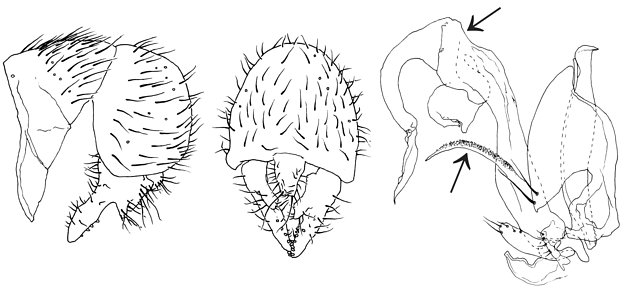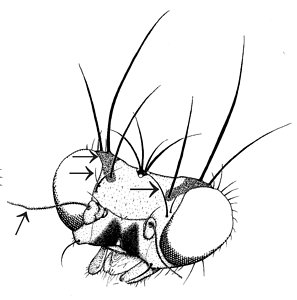Apiochaeta
Owen Lonsdale and Steve MarshallIntroduction
Apiochaeta Czerny is a yellow, bivittate (the scutum is occasionally brown) clusiid 3.0-5.1 mm in length that can be most readily identified by synapomorphies of the head: mid fronto-orbital ?-2/3 length of posterior and anterior fronto-orbitals; hind fronto-orbital inset; head and face relatively wide (ratio of head height to width 0.61 to 0.68); posterior corners of frons shiny brown to dark yellow; gena with dorsal white tomentose band, median yellow tomentose band, and ventral yellow shiny band. Like some other Clusiinae, Apiochaeta also has three dorsocentral bristles, an inclinate anterior fronto-orbital bristle, black setulae on the frons, outstanding bristles on the posterodorsal surface of the fore femur, a dorsal preapical bristle on the mid tibia, an angulate cell dm, a small ratio of the length of the ultimate section of vein M to the penultimate, an elongate curved distiphallus with one pair of basolateral spinulose projections, and a ventral receptacle with numerous transverse wrinkles and two ventral longitudinal furrows.
Alloclusia Hendel and Apiochaeta are the only South America Clusiinae, found in Chile and western Argentina. The only other Clusiidae in temperate South America are a few widespread species of the clusiodine genera Craspedochaeta Czerny and Heteromeringia Czerny.
Characteristics
Alloclusia, like Apiochaeta, can be readily diagnosed by three dorsocentral bristles, an angulate cell dm, an elongate curved distiphallus with one pair of lateral spinulose projections, and a ventral receptacle with numerous transverse wrinkles and two ventral longitudinal furrows. Apiochaeta differs from Alloclusia, however, by having short lateral scutellar bristles, short anterior dorsocentrals, a small inset mid fronto-orbital, a wide head and face, a dark shiny orbital plate, a banded gena, and brown fore tibiae and tarsi.
Like other Clusiinae, Apiochaeta also has an inclinate anterior fronto-orbital bristle, a small ratio of the length of the ultimate section of vein M to the penultimate, a subnotal stripe, a dorsal preapical bristle on the mid tibia, outstanding bristles on the posterodorsal surface of the fore femur, a bent or jointed distiphallus, and a posteromedial truncated notch on the vertex (Lonsdale & Marshall in press).
 image info
image info
Figure: Apiochaeta aequalis Malloch male genitalia; hypandrial complex not to scale. ? Owen Lonsdale.
Phylogenetics
Within the Clusiinae, Alloclusia and Apiochaeta form a monophyletic group based of three pairs of well-developed dorsocentral bristles, an angulate cell dm, a distiphallus with spinulose basolateral projections, and a ventral receptacle with numerous transverse wrinkles and two ventral longitudinal furrows.
Malloch (1933) last revised the species of Alloclusia and Apiochaeta, describing nine of the 14 known species. An identification key and some illustrations of the wings and surstyli were also provided. Prior to Malloch's paper, Czerny (1903) and Melander & Argo (1924) revised the species in these genera, although only four species were known at the time. A phylogenetic study of these two genera is currently being developed (Lonsdale & Marshall in manuscript).
References
Czerny, P.L. 1903. Revision der Heteroneuriden. Wiener Entomologische Zeitung 22(3): 61-108.
Lonsdale, O & Marshall, S.A. In press. Redefinition of the Clusiinae and Clusiodinae, description of the new subfamily Sobarocephalinae, revision of the genus Chaetoclusia and a description of Procerosoma gen. nov. (Diptera: Clusiidae). European Journal of Entomology.
Melander, A.L. & N.G. Argo. 1924. Revision of the two-winged flies of the family Clusiidae. Proceedings of the United States Natural History Museum 64: 1-54.
Malloch, J.R. 1933. The Diptera of Patagonia and South Chile. Clusiidae. British Museum of Natural History, pt. VI pp. 232-245.
Title Illustrations
| Scientific Name | Apiochaeta connexa Malloch |
|---|---|
| Specimen Condition | Dead Specimen |
| Life Cycle Stage | Adult |
| Body Part | Head |
| Copyright | © Owen Lonsdale |
About This Page
Owen Lonsdale
Insect Systematics Lab
Department of Environmental Biology
University of Guelph
Guelph, ON
N1G 2W1
Canada
Steve Marshall
Insect Systematics Lab
Department of Environmental Biology
University of Guelph
Guelph, ON
N1G 2W1
Canada
Correspondence regarding this page should be directed to Owen Lonsdale at and Steve Marshall at
Page copyright © 2005 Owen Lonsdale and Steve Marshall
- First online 25 August 2005
Citing this page:
Lonsdale, Owen and Marshall, Steve. 2005. Apiochaeta. Version 25 August 2005 (under construction). http://tolweb.org/Apiochaeta/27673/2005.08.25 in The Tree of Life Web Project, http://tolweb.org/








